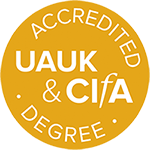Displaying 54 projects
At the intersection among the arts, science, and technology, printing is widely recognised as the invention of the millennium. However, and in spite of a resurgence of traditional typographic methods among artists and craftspeople, letterpress equipment and technology face an uncertain future...
Digital Humanities Research Project and Interactive Digital Rock-Art Gallery.
The above photo shows: A left lateral aspect of a cranium from Catignano (a Middle Neolithic village in Abruzzo), showing two healing trepanations on the left parietal bone and healed fracture on the left frontal and parietal bones of a 40-50 year old female How did politics and inequality work in...
Analysis and evaluation of bronze axe hoards during the Late Bronze Age - Iron Age transition. The project investigates provenance, chronology, technological and cultural aspects of bronze deposition of the European Atlantic region.
Investigating the changing social landscape of the southern Danish island of Als from the Neolithic to the Viking period.
Archaeological data is often biased and incomplete. This is a well-known issue for most archaeologists. Although studies of specific sites and small regions can have this into account, the effect of this problem increases exponentially as archaeologists expand their chronological and geographic...
The bioarchaeological characterization of disabled individuals from the past is particularly challenging because it pushes the boundaries of the interpretation of pathologies recognisable on human remains. With my project, namely B-CARED, I will investigate the bioarchaeological approaches for...
The aim of the ERC project Beasts to Craft (B2C) is to document the biological and craft records in parchment in order to reveal the entangled histories of improvement and parchment production in Europe from 500-1900 AD.
Excavation and survey in southern Aspromonte.
A multidisciplinary project investigating the interrelations between crop plants, insect pollinators, and human management in prehistory.
Cultural Heritage of Dictatorship in Albania.
Introduction to the CRIC Project.
Excavation in the cemetery area of the ancient Latin town of Crustumerium, Rome.
Divergent Meanings: understanding the postmortem fate of human bodies found in Neolithic settlements from the Balkan area in light of interdisciplinary data.
The project will research how archaeological and palaeoecological narratives of past land management and climate change adaptation can shape sustainable farming, regenerative agriculture, and rewilding strategies in the Cambridgeshire Fenlands. The nationally important agricultural area is...
Our knowledge of human evolution is limited by several factors. One is tightly linked to the nature of the fossil record, as bones of our extinct human relatives and other primate species rarely appear in archaeological and paleontological sites, and when they do, they very commonly appear in an...
This archaeology-led initiative focuses on the East Anglian Fens, an extraordinary landscape where exceptional preservation of organic artefacts and environmental evidence gives unparalleled insights into the last 5,000 years of communities, resources and habitats. The Fens are the richest and most...
Food globalisation in prehistory (FOGLIP) project employs archaeobotany, genetics, stable isotope analyses and ethno-archaeology to establish when and how early globalisation of staple foodstuffs occurred.
This project takes as its focus the 1937 aerial bombardment of Gernika as a political and artistic event rooted in—and in ongoing dialogue with—colonial violence in the Middle East & North Africa. It connects the 1920s aerial bombardment of civilians in colonial Iraq, Syria, Afghanistan, and...
The last decades have witnessed marked achievements of STEM in understanding the remains of humans, animals, and plants from the past by analyzing different materials, both inorganic and organic. These developments have opened-up the great potential for increasing our understanding of cultural...
This project regards the application and development of novel techniques of landscape archaeology in central Tyrrhenian, Italy.
A large-scale multi-disciplinary study of pre-Roman iron technology in the Iberian Peninsula.
Northern Bosnia is a key location in which to investigate human-environment interactions in the Late Pleistocene /Middle-Upper Palaeolithic. Our research aims to evaluate hominan resource networks and investigate palaeoenvironmental conditions during this period, and address the following...
The excavation of a WWII forced labour camp in order to explore the daily life of internment under German occupation.
Taking as its starting point the radically new perspective offered by recent archaeological discoveries at Rendlesham in SE Suffolk, and with the East Anglian kingdom as the primary case study, this interdisciplinary project (running 2017-2020) aims to establish a new understanding of pathways to...
MendTheGap - Smart Integration of Genetics with Sciences of the Past in Croatia.
The project focuses on the models of circulation of raw materials during the Iberian Late Prehistory, as well as the use and social value given to the different materials, with special attention to metals and amber.
The Must Farm project is the first landscape scale archaeological investigation of deep Fenland, with its complex geological history.
A project investigating Modern human dispersal into Eurasia and its relation to Neanderthal extinction during the Middle to Upper Paleolithic transition.
Excavations and survey work at the ancient town of Nepi carried out during the early 1990s under the umbrella of the Tiber valley project of the British School at Rome .
This project integrates maritime archaeology, history, geophysical survey and anthropology to investigate illicit trade between the Caribbean islands St. Eustatius, Saba, St. Thomas, St. Bartholomew and St. Maarten from 1816 to c.1840 with the aim of understanding: -The entanglements between...
Quantitative meta-analysis of f ish bones recovered from archaeological excavations with the aim of tracing human use of marine resources over the last 2000 years.
The PROCON project explores the role of textile production and consumption in the formation of early states, using the example of Mediterranean Europe during 1000-500 BCE.
During the medieval and renaissance periods, the Low Countries were a key region for trade, international finance, and the arts. Cities such as Bruges, Ghent, Brussels, Amsterdam and Leiden developed large populations, and with high population comes the problems of sanitation. Medieval populations...
The aim of this project is to better understand the health consequences of parasitism in the Roman world. The Romans were responsible for introducing sanitation and hygiene infrastructure to those parts their empire where it did not exist before. Communal latrines for town inhabitants, individual...
Caractérisation du comportement et adaptation des Néandertals et les hommes modernes pendant la transition entre le Paléolithique moyen et supérieur.
Caracterización del comportamiento y adaptación de los neandertales y humanos modernos durante la transición entre el Paleolítico medio y superior.
Changing Paleoenvironments and Hunter-Gatherer Strategies in the Northern Adriatic Basin.
Fordwich has been revealed to be the oldest directly-dated Acheulean occurrence in the United Kingdom, with artefacts dating from 560,000 to 620,000 years ago (MIS 15). This makes it the second oldest Acheulean site in north-west Europe, and the oldest to display a known handaxe assemblage...
Recording, analysing and interpreting the art of prehistoric fisher-gatherer-hunters in Southeastern Scandinavia.
A study of the Roman pottery of the Nepi Survey Project in 2007.
This five-year project funded by the International Holocaust Remembrance Alliance seeks to write European heritage guidelines for Holocaust and Roma genocide sites in order to safeguard them for the future.
The project Science @ Tarquinia aims to provide the complementary scientific support for the long-standing study of the ancient Etruscan city of Tarquinia by the University of Milan. This Unesco World Heritage site is well known for its magnificent painted tombs, its city walls, the Temple of Ara...
A series of inter-related projects are enhancing knowledge of the South (east) Etruria area north of Rome.
A Bronze Age fortified tell settlement on the right bank of the river Danube 30km south of Budapest.
Excavations at the Brough of Deerness, an enigmatic Viking Age site in Orkney.
Cambridge is home to world-leading researchers across archaeological science, technical art history and heritage science, based at Department of Archaeology, the Fitzwilliam Museum, and the Hamilton Kerr Institute, among others. There are multiple synergies across these institutions in terms of...
What does a river do? As anyone who has lived by one knows, rivers structure human worlds in many ways. This project explores the role of Europe’s greatest river in the formation of new societies, in and after the last centuries of the Roman Empire in the West (150–700 AD). The Danube occupied a...
Researching how and where broomcorn millet was first domesticated and why it appears on opposite sides of Asia at a similar time, 8,000 years ago.
Investigating unsolved problems of the fourth and third millennium BC in Malta.
Bioarchaeological analysis of early cold-climate human ecology.
This project will challenge the extant model on the beginning and spread of Islamic glazes, which asserts that they were all derived from the Middle East and spread with Arab expansion, and that new technologies were adopted passively by conquered societies. It will include a variety of glazed ware types dating to the 9th to 13th centuries CE from different regions of Central Asia.
Visual Perception and Cognition in the Rock Carvings of Northern Russia.
Характеристика поведения и адаптации неандертальцев и современных людей к условиям МИС 3, включая условия перехода от среднего к верхнему палеолиту.


